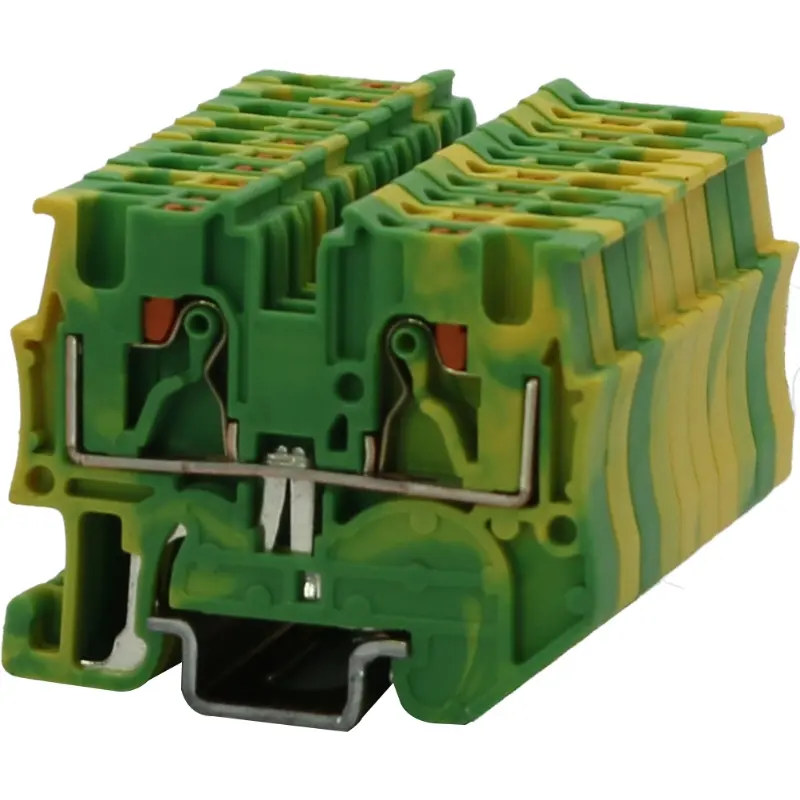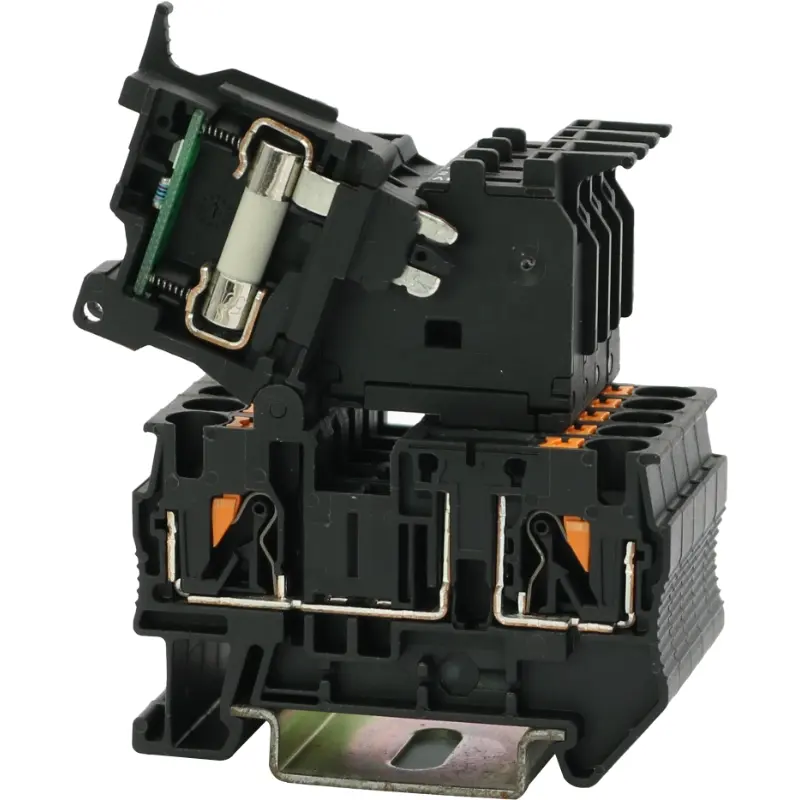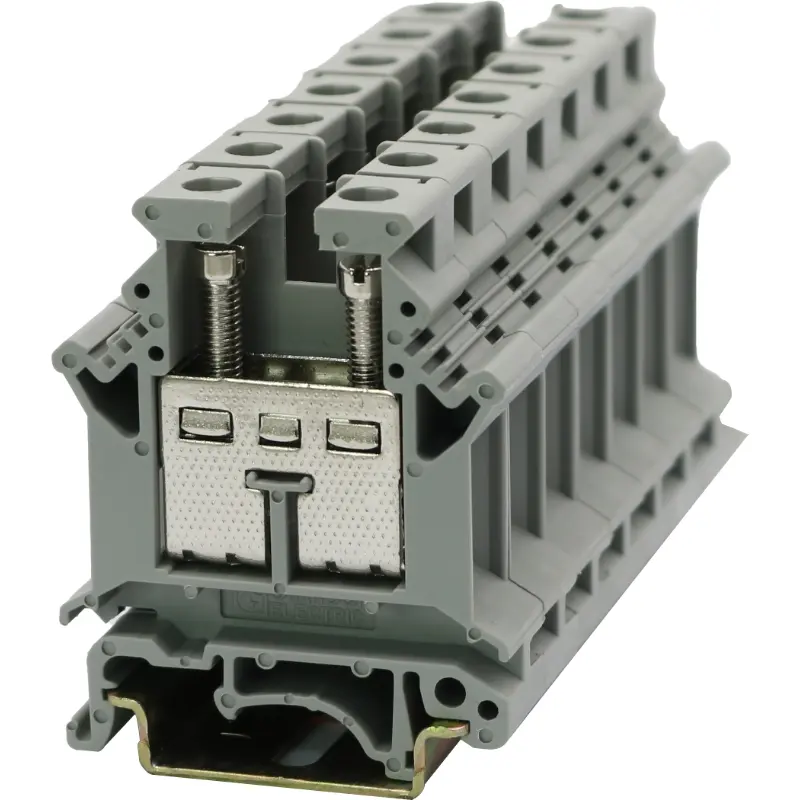При монтаже электрооборудования выбор правильных клеммных колодок имеет решающее значение для обеспечения безопасности, эффективности и надежности. Клеммные колодки на DIN-рейку широко используются в промышленных и коммерческих условиях благодаря своей универсальности и простоте установки. В этом руководстве подробно рассматривается, что следует учитывать при выборе клеммных колодок для ваших проектов.
Понимание текущего рейтинга
Номинальный ток клеммной колодки указывает, какой ток она может безопасно выдерживать. Выбор правильного номинала имеет важное значение для предотвращения перегрева и обеспечения долговечности системы.
Определите свою нагрузку: оцените максимальный ток, который будет потреблять ваше приложение. Эта информация часто доступна из спецификаций подключенных устройств.
Запас прочности: разумно выбрать клеммную колодку с более высоким номинальным током, чем ваши расчетные потребности. Это не только повышает безопасность, но и учитывает потенциальные будущие увеличения нагрузки.
Если ожидается, что ваша система будет потреблять до 10 А, рассмотрите клеммную колодку, рассчитанную как минимум на 15 А или более.

Соображения относительно номинального напряжения
Номинальное напряжение является еще одним критическим фактором; оно указывает максимальное напряжение, которое клеммная колодка может выдержать без риска выхода из строя.
Соответствие напряжению системы: убедитесь, что номинальное напряжение клеммной колодки превышает максимальное напряжение в вашем приложении, чтобы избежать поломок.
Соответствие стандартам: выбирайте блоки, соответствующие отраслевым стандартам (например, IEC 60947 или UL 1059), чтобы гарантировать безопасность и производительность.
Для системы, работающей при напряжении 230 В, выбирайте клеммную колодку, рассчитанную как минимум на 300 В.
Совместимость размеров проводов
Размер проводов, которые вы планируете подключить, напрямую влияет на выбор клеммной колодки.
Проверьте калибр провода: клеммные колодки имеют определенную совместимость с размером провода (измеряется в AWG или мм²). Убедитесь, что блок подходит для вашего калибра провода.
Длина зачистки: для разных клеммных колодок может потребоваться разная длина зачистки; ознакомьтесь с рекомендациями производителя для определения оптимальных соединений.
При использовании провода калибра 16 AWG выберите клеммную колодку, поддерживающую провода калибра 16–14 AWG.

Используемые изоляционные материалы
Изоляционный материал влияет на тепловые и электрические характеристики клеммных колодок.
Распространенные материалы: полиамид (ПА) обычно используется из-за его прочности, в то время как поликарбонат (ПК) предпочтительнее в условиях высоких температур.
Тепловые свойства: Оцените тепловые свойства изоляционного материала, чтобы убедиться, что он может выдерживать рабочую температуру вашего объекта.
Сравнение:
Полиамид (ПА): подходит для общего применения; термостойкость около 100°C.
Поликарбонат (ПК): подходит для применения в условиях высоких нагрузок; выдерживает температуру до 130°C.
Условия окружающей среды
Учитывайте среду, в которой будут установлены клеммные колодки.
Диапазон температур: проверьте диапазон рабочих температур, указанный производителем.
Влажность: для влажных сред выбирайте клеммные колодки с высоким классом защиты IP (Ingress Protection), что означает устойчивость к влаге.
Воздействие химикатов: если присутствуют химикаты, выбирайте материалы, устойчивые к коррозии и разрушению.
Для наружной установки выбирайте клеммные колодки со степенью защиты IP65, которые обеспечивают защиту от пыли и воды.
Монтаж и ограничения по пространству
Системы DIN-реек разработаны для эффективного использования пространства, но важно учитывать следующее:
Размер клеммных колодок: Измерьте доступное пространство на вашей DIN-рейке, чтобы избежать переполнения. Выбирайте компактные конструкции, если пространство ограничено.
Многоуровневые варианты: если вам требуется больше соединений на небольшой площади, рассмотрите возможность использования многоуровневых клеммных колодок.

Типы подключения
Способы подключения проводов к клеммным колодкам могут различаться, что влияет на скорость и надежность монтажа.
Винтовые клеммы: обеспечивают прочное и безопасное соединение, но для установки требуется отвертка.
Пружинные клеммы: обеспечивают быстрое подключение без использования инструментов; отлично подходят для случаев, когда требуется частая замена.
Вставные клеммы: упрощают процесс подключения — просто вставьте провод на место.
Плюсы и минусы:
Винтовые клеммы: более надежны, но медленнее устанавливаются.
Пружинный зажим: быстрая установка, но может не обеспечивать надежной фиксации при сильной вибрации.
Дополнительные возможности
Выбирайте клеммные колодки, обладающие функциями, повышающими удобство использования и функциональность.
Контрольные точки: некоторые клеммные колодки оснащены контрольными точками для легкой проверки цепи без отсоединения проводов.
Варианты маркировки: выбирайте блоки, которые позволяют четко маркировать клеммы, что особенно полезно при сложных установках.
Соображения стоимости
Хотя бюджет не должен быть единственным фактором, важно найти клеммные колодки, которые предлагают хорошее соотношение цены и качества.
Сравните варианты: рассмотрите разных производителей и модели, чтобы найти баланс между стоимостью и качеством.
Долгосрочные инвестиции: иногда небольшие первоначальные затраты могут сэкономить средства в долгосрочной перспективе за счет снижения потребности в техническом обслуживании и замене.
Заключение
Выбор правильного Клеммные колодки на DIN-рейку Может показаться сложным, но тщательно рассмотрев такие факторы, как номинальные значения тока и напряжения, совместимость проводов, изоляционные материалы, условия окружающей среды, варианты монтажа, типы соединений и дополнительные функции, вы сможете принять обоснованное решение. Всегда сверяйтесь со спецификациями и рекомендациями производителя для достижения наилучших результатов. Удачной электропроводки, и пусть ваши электротехнические проекты будут безопасными и успешными!
